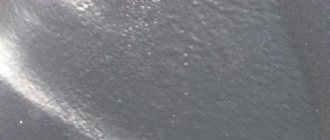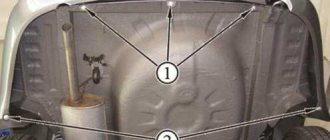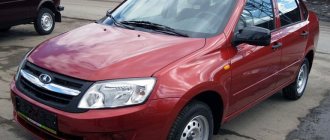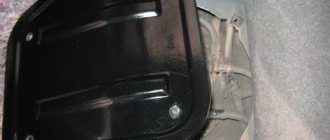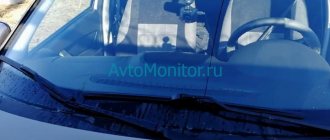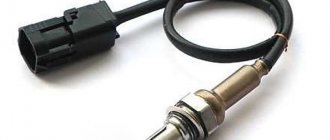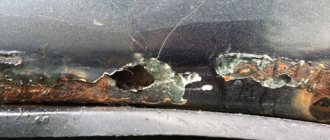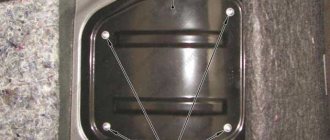Automobile: Lada Granta. Asks: Anonymous. Question: Is it necessary to treat the body or underbody of the Lada Granta?
I have long wanted to ask how to treat the underbody of a Granta sedan? Of course, there is no standard processing. So far I don’t see any problems with corrosion, but I wanted to be on the safe side. Or maybe it makes sense to protect some other details? How exactly and with what to process them is what interests me.
Anti-corrosion treatment of Lada Granta
As with any car, do-it-yourself anti-corrosion treatment of the Lada Granta is necessary to increase the life of the car body and maintain its normal appearance.
New Lada Granta.
Lada Granta is structurally worked out quite competently:
- the number of parts in various units is reduced to a minimum;
- enlarged air intakes in the bumper are used;
- a high-quality, comfortable and reliable car that can be used in any weather conditions.
Do-it-yourself body protection
Despite the fact that such new materials as two-component polyester-based primers and two-layer metallized enamels were used to paint the Lada Granta car, the car needs protection from corrosion, because its operation, especially in winter conditions, is associated with a number of negative impacts.
The sooner the car owner does the body treatment, the more he will extend the service life and maintain the beautiful appearance of the car.
Salons offer protection when purchasing a new car. Anti-corrosion treatment by specialists costs about 6 thousand rubles, and 5 thousand is the price of the work.
It is more economical to do the processing yourself
You can do high-quality processing yourself and save money. It is not necessary to have a compressor or other specialized equipment.
Is the Lada Granta galvanized? How to extend the life of a car?
Potential buyers and car owners are concerned with the question: does the Grant model have a galvanized body or not? The concern is easy to understand: the cost of the body is a significant part of the price of the budget car Lada Granta, galvanization protects the structure from the influence of adverse external factors.
Different sources provide conflicting information. Official representatives of the AvtoVAZ concern claim: the Lada Grant has a galvanized body, some sales dealers refute the statement.
How to care for an expensive car body, regardless of whether the body of the Lada Grant is galvanized or not?
Processing details to pay special attention to
Lada Granta, whose factory anticorrosive is only a small part of the necessary measures to protect the body, requires additional protection. Anticorrosive Lada Granta is an event that requires a holistic approach, however, there are places where the Lada Granta body is treated that should be given special attention.
So, for example, anti-corrosion treatment of Lada Granta thresholds is a paramount condition for protecting the car body. Susceptibility to corrosion thresholds is a consequence of the greatest physical impact compared to other parts of the body. Other elements to pay attention to include:
- bottom. It is on this that the protective function falls, which ensures that excess moisture does not penetrate. Even installed protection will not provide a complete guarantee of the absence of corrosion.
- wheel arches. Constant exposure to water and dirt from the wheels does its job.
Types of anti-corrosion treatment
There is a huge range of materials on sale to protect the car body, which differ in application methods and characteristics. Modern, high-quality preparations provide reliable coverage that does not cause harm to health.
Anticorrosive treatment affects areas of the body that are not visible, so the appearance of the Lada Grant will not deteriorate.
For external treatment, aerosols are used.
All anti-corrosion agents can be divided into 2 groups: products for external and hidden surfaces. PVC materials, liquid plastic, bitumen mastic, materials with rubber are products for the external parts of the car.
For internal cavities, special preparations containing oils are used, which retain a liquid state for a long time. Products with paraffin are used, which form a waxy film. This anticorrosive agent retains its elasticity during temperature changes.
Lada Granta can be protected with D-11A plastisol, a special composition NGM-ML, and BPM-1 bitumen mastic. These materials tend to reduce noise in the cabin, which is an additional good quality. Other products can be used, but they must be certified and made by a reliable manufacturer. It is better to buy materials in specialized stores.
It won't rust behind us! What anticorrosive agent do you need?
The principle of operation of all anti-corrosion agents is approximately the same - to isolate the treated areas from moisture and other foreign substances such as dirt and reagents, which, when mixed with water, act as “accelerators” of corrosion.
What places need to be treated with anticorrosive agent?
In addition to the obviously accessible areas of the car, such as the underbody and arches, you also need to treat hidden areas that are at risk. These are various kinds of cavities in the sills, doors and wings. Welding and rolling seams also often suffer, since moisture also gets into the space between the sheets of metal and corrosion begins.
Where to start
It will sound ironic, but we need to start with water. It is necessary to thoroughly rinse all areas of the body that will be treated with anticorrosive. Preferably with foamy substances to ensure that you get rid of dirt and reagent residues that can ruin the effect.
After washing, you need to dry the washed parts of the body as much as possible and make sure that no moisture remains in hidden cavities. In professional centers, heat guns are used for drying, aimed at the bottom of the car. But in a garage, you can get by by leaving the car to dry for a couple of days.
What to do if there is already rust
An extremely important point: before applying anticorrosive to the body, you need to get rid of areas with corrosion. If you apply anticorrosive agent over a rusty area, the effect will be approximately zero. Therefore, it is better to take a sandpaper and walk over the areas of corrosion to clean them. After this, you need to thoroughly degrease them and dry them.
Be sure to cover the brake mechanisms, suspension parts, sensors and other elements that you do not want to get into. Garbage bags and masking tape work well for this.
Applying putty
It makes sense to putty thresholds only on previously prepared metal. A carefully cleaned and degreased surface with your own hands is an excellent basis for applying putty. Working on an unprepared part guarantees rapid peeling and poor fit of the filler. It is unlikely that there will be any point in filling the threshold directly over the paint or primary primer.
It is necessary to add the hardener to the composition shortly before use. The preparation time for the working mixture should be approximately one minute, and the mass of the hardener should be within 2-4% of the mass of the entire composition.
In this case, 5–7 minutes are allotted for processing the car part, after which the process of solidification of the composition will begin and it will be useless to do anything with it. The putty is applied in portions, in thin layers, stopping for 5-10 minutes to dry. By pressing on the composition with a spatula, excess air is removed from the mass.
In the room where you are filling your car yourself, a certain temperature and humidity must be maintained. If the moisture level exceeds the specified level, the mixture will not harden completely, and at high temperatures, setting will occur too quickly. When using putty with fiberglass, you need to take into account that its pores are difficult to cover with primer. In this case, liquid finishing putty should be used. After the putty has dried, before painting, the thresholds are sanded by hand or with a sanding machine.
Step-by-step instruction
Before starting repair work, it is necessary to inspect the body and identify all problem areas. Assess the degree of damage and decide on a method to eliminate corrosion.
Tools and materials
Before starting work you need to prepare:
- grinder;
- sandpaper;
- degreaser;
- putty;
- primer;
- paint;
- car varnish;
- rust converter;
- masking tape;
- clean cloth.
Mechanical method
Removing rust stains mechanically is carried out in several stages:
cleaning corrosion down to metal with sandpaper. The work can be done manually or using a power tool, such as a grinder
The stain should be cleaned gradually and carefully, avoiding the appearance of rough scratches. It is important not to damage entire areas of the paintwork and carry out 100% complete cleaning to “bare” metal
- treating the prepared area of the body with a rust converter in order to eliminate the smallest corrosion residues that are not always visible to the eye.
- degreasing the surface after the converter ends (on average after half an hour);
- putty (carried out in several layers if necessary) and grinding of the treated surface;
- painting in body color (before painting, protect adjacent parts of the body with newspapers and masking tape and apply an anti-corrosion primer in 2-3 layers). Painting is also carried out in 2-3 layers, each thoroughly drying.
- application of clear varnish (if desired) for more reliable protection and a beautiful appearance.
Watch a video on how to remove rust from a car in 10 minutes:
Chemical method
As a rule, such preparations are applied to the problem area in accordance with the manufacturer's instructions for the specified time, after which the remaining product is wiped off or washed off.
However, to obtain an excellent and long-lasting result, you will also have to putty, sand and paint. When eliminating minor damage to the body, you can do without these steps.
Popular drugs
The most popular chemicals for removing rust from a car body with your own hands are:
- orthophosphoric acid is the most well-known remedy; it can be used in its pure form or be part of various chemistry;
- VSN-1 Neutralizer - easily copes with rust, turning it into a dark mass;
- zinc - a kit for removing rust and further galvanizing the metal by applying a special protective layer using an electrochemical method. Requires connection to battery. The process of working with the Zinkor product can be seen in detail in the video clip:
Work technology, materials used
Anti-corrosion treatment of Lada Granta is carried out in several stages.
- washing;
- drying;
- visual inspection;
- removing rust;
- processing of internal cavities;
- coating of external surfaces of the body;
- assembly.
External processing is carried out on an overpass or from an inspection hole
To carry out the work you need to prepare:
- anticorrosive black "Tektil" - 5 kg;
- aerosol cans of Tektil ML - 4 pcs.;
- brushes of different widths and hardness;
- latex gloves;
- plastic tube;
- metalworking tools;
- solvent.
To work, you will need an inspection pit or overpass with a lift.
Myth 2: A galvanized body does not rust.
Therefore, factories perform galvanic galvanization, as a result of which a layer of zinc up to 0.015 mm thick is formed on the surface of the steel. This zinc layer is quite economical in terms of production costs and provides good protection. However, it is easily damaged mechanically. And not only as a result of an accident, but also due to abrasive effects on the surface of the body.
Also, the zinc layer is damaged during operation, during which the body experiences various bending and deforming loads. Because of them, corrosion first appears at welding points and at joints - numerous power and moving elements of any body. Therefore, even a good galvanized body will never benefit from additional anti-corrosion protection.
What is galvanized on the Lada Granta?
First, let's look at galvanization: the only model that does not have galvanized body parts is the short-wheelbase Niva (Lada 4×4). Journalists said the same thing about Granta, although in fact 32% of the parts here are galvanized.
The body floor is galvanized on one side, the floor screen is galvanized on both sides. In general, there is no particular point in anticorrosive treatment.
This is a ferrous metal, and zinc is on the outside
Usually they do this:
- The bottom and fender liners can be coated with bitumen mastic;
- Movil is poured into the rapids, you need to ride with it for a couple of days and then drain it - a quick-drying composition is not suitable!
- Hidden cavities are treated with Movil aerosol or Tektil ML.
Main stages:
- The working surface is washed with hot water under pressure from 60 to 100 atmospheres and dried by blowing hot air for 15 to 30 minutes. When using a heat gun, the processing time increases significantly.
- A thorough inspection and identification of defects is carried out. The condition can be assessed using special instruments or visually. The car with the wheels removed must be on a lift at this time.
- Before starting work, all components and parts that cannot be processed are closed. Brake discs are covered with plastic covers, other parts are sealed with tape.
- Hidden cavities and hard-to-reach places are treated with special devices capable of applying anti-corrosion material under pressure of 6-8 atmospheres. Thanks to high pressure, it penetrates into all cracks and, settling, forms a protective film.
- Wheel arches and the bottom are processed using a brush or spatula, 250-300 microns thick. With a thicker layer, it may subsequently crack and begin to peel off. Drying the treated surfaces takes about a day.
Anticorrosion options
Since the design features of the machine include hidden spaces, it is necessary to divide the funds into:
– means for treating accessible surfaces
– products for treating hard-to-reach surfaces
Products applicable to accessible surfaces contain the following active ingredients:
– liquid plastic – rubber – mastic (bitumen)
Places most susceptible to corrosion are usually treated with oil-containing preparations - they allow you to create a certain film that can remain in place for a long time. Anticorrosive on Grant must withstand all the vagaries of the weather.
For areas where car operation involves frequent encounters with moisture, a product based on paraffin can be used - its use also allows the film to remain on the surface for a long time.
The most painful place
Whatever car you choose, frequently inspect the traditional places where you can notice the first signs of corrosion: panel joints, bumpers, arches, hood trims, bottoms of doors, sills, A-pillars, roof edges front and rear. And, of course, the most painful place is under the rear license plate frame.
And still keep in mind: one day rust will get to any car with an iron body.
- Seven phrases to reduce the price of a used car, here.
- Are you faced with the problem of glass and brushes icing? Use BURNER heated brushes! To keep your side windows clean, purchase a windshield drain.
- A pragmatic way to improve the equipment of a car is roof rails. Our online store offers useful car accessories on the best terms.
Photo: manufacturing companies
It will rust behind them. Top 5 cars that rot quickly
New reviews about car services (anti-corrosion treatment of a vaz lada granta car) in Moscow
Excellent service - the specialists are all Russian, the prices are very reasonable, I am satisfied.
It was November 8, 2022, a diagnostic of the spar was required, they checked it quickly, found a little rust, sanded it down, treated it with a converter, coated it with anti-corrosive and painted it on top in body color, excellent quality, price was great.
A disregard for clients, in general, this is more a problem of the administration than of the craftsmen. In general, be prepared for rudeness
They don’t know how to serve what is stated here
Self-processing - is it possible?
Since high-quality car processing in specialized services will cost a pretty penny, sophisticated owners, after studying the issues of how to process a Lada Granta video, began to implement the acquired knowledge.
First of all, if you decide to carry out the processing yourself, you must understand that without certain skills and special equipment, the quality of the result will be poor.
You can achieve adequate results only by strictly following the instructions. Thus, do-it-yourself anticorrosive Lada Granta is a matter that requires collecting information, without which it is impossible to take into account all the features and subtleties of the process.
Causes of corrosion in the Lada Granta
About a third of the Lada Granta's parts are made of specialized alloys. But bad roads, salt and reagents that are sprinkled on the asphalt, and our difficult climate with sudden temperature changes lead to the fact that corrosion quickly begins to corrode the metal elements of the body. There are many reasons why rust may appear, but the main ones are:
- improper operation and storage of the vehicle;
- poor quality factory processing;
- special design of Lada Granta;
- machine operation in adverse weather conditions.
Don't wait for the first signs of corrosion to appear. To increase the active “life” of your car, do it yourself or order anti-corrosion treatment of the body at a service station.
Types of anticorrosion agents for Lada Granta
Before you begin work on treating your car with anticorrosive, you need to decide on the choice of materials. To do this, you need to understand what they are and how they differ. The range of these products on the market is huge, and they are divided according to the method of application and special properties. Innovative products, most often used in workshops or when processing in-house, are reliable and environmentally friendly. These compositions are of two types:
- for external surfaces;
- for hidden areas.
Anticorrosives such as liquid plastic, bitumen mastic, PVC-based materials and rubber mastics are used for external parts of cars. For internal areas, specialized preparations with oils are used that do not dry out for a long time. Materials with paraffin are also used, after hardening they form a waterproof elastic film. It does not change its structure at any temperature.
What do official representatives of the domestic auto giant say?
At the factory, the metal body panels of the Lada Grant are treated with a zinc layer. The low cost of the model we are considering does not allow such coverage over the entire body area. The most vulnerable areas are subject to protection. This applies to:
- door panels;
- hind wings;
- niches for stern wheels;
- luggage compartment covers;
- protective body screen;
- bottoms;
- rear fender gutters.
This statement gives an understanding of the issue regarding the galvanization of body components of the Lada Grant. In this regard, discussions around the products of the domestic auto industry are heating up with serious force. While fans and owners continue to argue, AvtoVAZ is improving its car production strategy, the list of main priorities of which includes galvanizing body components.
Factory conditions require the application of the following types of coatings:
- thermal galvanizing, which is the most reliable means of processing;
- galvanization, which involves obtaining a zinc layer on body panels formed by an appropriate solution under the influence of an electric current;
- a primer coating that involves the preliminary application of salts containing impurities of manganese, zinc and iron to the metal surface.
More details about the location of corrosion
If the other components of the car are still in good working order, the body did not withstand the harsh tests. Below, near the front right fender, the paint has bulged thoroughly.
I will do it and immediately write a publication for you, maybe it will be useful to someone.
Timely processing and reasons for its need
Lada Granta, anti-corrosion treatment of which has now become an important maintenance element, needs it, since during operation the car constantly encounters factors that cause corrosion. These include:
– Weather conditions that create high humidity and constant contact of the body with water.
– Poor quality of the top coating layer.
As sad as this may sound, the outer layer of the Grant is actually made of cheap materials that are more susceptible to corrosion than high-quality coatings. Anti-corrosion treatment of Lada Granta is a necessity caused by operating conditions.
Anticorrosive treatment. Quality criteria:
As is known, all protective coatings have their own critical thickness, below which long-term protective properties decrease. The physical characteristics of the materials and equipment must ensure that the required thickness of the coating is applied.
The complexity of the body structure with an abundance of hidden cavities requires anti-corrosion materials to have special properties such as penetrating ability and moisture displacement. So, the protective properties of the coating are ensured by applying a film layer of at least a critical thickness.
Penetrating ability is ensured by the penetration of the material into micro-gaps to an effective depth and height in the required quantity. The moisture-displacing ability is ensured by the distribution of the film over the entire area of the wet surface.
All cavities are treated from the outside through small technological openings using spray nozzles in the absence of visual control. Consequently, the equipment and fixtures used must guarantee the application of anti-corrosion compounds within the normal film thickness and in the proper volume. Good command of the spraying technique combined with knowledge of the structure of the hidden cavities of the body is a mandatory requirement for a specialist in anti-corrosion treatment; pay attention to this point if you decide to do the anti-corrosion treatment yourself.
Make anticorrosive with your own hands. Features of materials:
Professional anti-corrosion compounds must have good thixotropy (the ability to remain in a horizontal position), i.e. After applying the coating to the surface, the film thickness should not decrease below a critical level due to runoff, dripping under the influence of temperature or vibration.
It is a fallacy to say that a material should not change its initial properties over time. According to the laws of physics and chemistry, this is impossible; changes inevitably occur. The best materials are distinguished by the fact that their protective properties change slowly and evenly. Thus, periodic renewal of the protective coating and additional anti-corrosive treatment are necessary.
The car body has hidden cavities of various configurations and sizes, located in different places. Accordingly, these cavities have different microclimates - humidity, temperature, electrolyte concentration. Some areas of the body, due to their aggressive microclimate, are more susceptible to corrosion. Such areas are called critical. Examples of such areas are cavities with an abundance of microgaps and welds. The lower they are located and the closer to the engine compartment, the higher the corrosion rate.
This happens for the following reasons:
- in microgaps the electrolyte lasts longer than in open areas;
- water from the road constantly gets onto the lower part of the body;
- areas near the engine compartment become hot.
